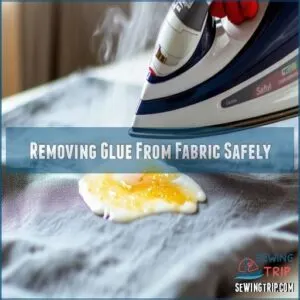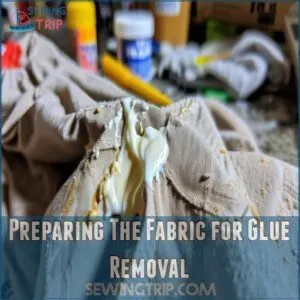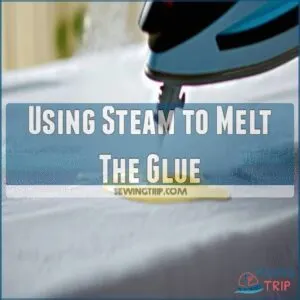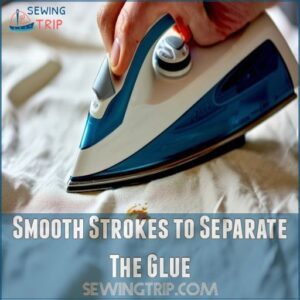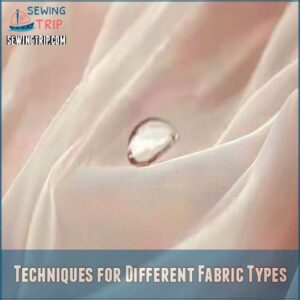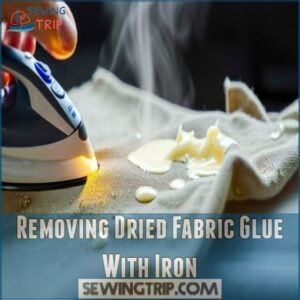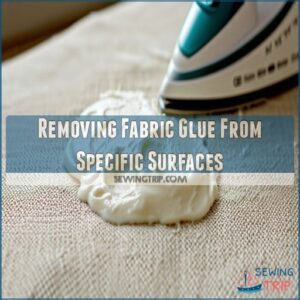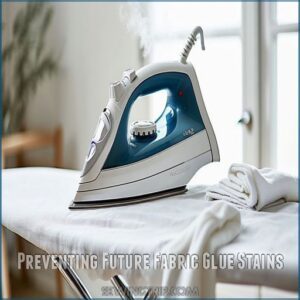This site is supported by our readers. We may earn a commission, at no cost to you, if you purchase through links.
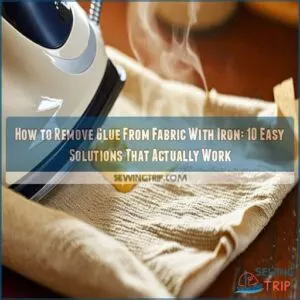 You’ll be amazed at how easily you can remove glue from fabric with an iron and a few household items.
You’ll be amazed at how easily you can remove glue from fabric with an iron and a few household items.
Start by placing your fabric glue-side down on an ironing board.
Cover the affected area with parchment paper, then set your iron to medium heat.
Press the iron over the paper for 10-15 seconds – the heat will soften the adhesive.
Once warm, gently scrape off the loosened glue with a dull knife.
For stubborn spots, repeat the process, adjusting the heat as needed.
And here’s a game-changer: certain household solutions can make this process even more effective when combined with heat.
Table Of Contents
- Key Takeaways
- Removing Glue From Fabric Safely
- How to Remove Glue From Fabric With Iron
- Preparing The Fabric for Glue Removal
- Applying Heat to Soften The Glue
- Techniques for Different Fabric Types
- Removing Dried Fabric Glue With Iron
- Removing Fabric Glue Stains After Ironing
- Removing Fabric Glue From Specific Surfaces
- Alternative Methods for Removing Fabric Glue
- Preventing Future Fabric Glue Stains
- Frequently Asked Questions (FAQs)
- Conclusion
Key Takeaways
- You’ll soften glue on fabric by placing a clean cloth over the stain, pressing with an iron on medium heat, and repeating until the glue transfers to the cloth.
- Always check your fabric’s care label to set the right iron temperature; synthetics need low heat, cotton handles medium-high, and delicate fabrics like silk demand low settings.
- Before using an iron, test your method on an inconspicuous area and scrape off excess glue with a dull knife to avoid fabric damage.
- When removing stubborn adhesives, consider the techniques used to tackle common issues like removing pencil marks from embroidery, which often involve gentle scrubbing and rinsing. Use a fabric softener solution or stain remover to tackle remaining adhesive after heat treatment, ensuring it’s safe for your fabric type.
Removing Glue From Fabric Safely
You’ll need to set your iron to the right temperature and prepare your workspace carefully before tackling that stubborn glue stain on your favorite fabric.
Before you tackle that stubborn glue stain on your favorite fabric, prepare your workspace carefully.
When you’re working with heat and adhesives, it’s important to take proper safety measures to protect both yourself and your cherished garments from potential damage.
Precautions Before Applying Heat
Before reaching for that iron, take a moment to identify the type of glue and fabric you’re dealing with.
Some adhesives can emit harmful fumes when heated, while delicate fabrics might melt under direct heat.
Always work in a well-ventilated area and keep a damp cloth nearby for emergencies.
Check the fabric care label first – if it says "dry clean only," skip the iron altogether.
Choosing The Right Iron Temperature
Setting the right iron temperature is important for successful glue removal without damaging your fabric.
Check your garment’s care label to determine the appropriate heat setting.
Here’s what you need to know:
- Polyester fabric can melt under excessive heat, but using the right techniques, such as those for ironing on patches to polyester, can help prevent damage. Synthetic fabrics need low heat (250-300°F)
- Cotton and linen can handle medium-high heat (300-400°F)
- Wool requires medium heat (280-320°F)
- Silk demands the lowest setting (250-275°F)
Always test on an inconspicuous area first to make sure it’s safe.
How to Remove Glue From Fabric With Iron
Tackling stubborn glue stains with an iron can be your secret weapon when other methods fall short.
You’ll need a clean iron, pressing cloth, and a bit of patience to master this technique.
Heat breaks down the adhesive bonds, making even the most stubborn glue removable with the right approach.
Here’s what you’ll need for successful glue removal:
- A clean iron with adjustable temperature settings
- A white pressing cloth or clean cotton fabric
- Heat-resistant surface or ironing board
- Access to running water
- Protective gloves for safety
The process works because heat softens most adhesives, allowing them to transfer from your garment onto another surface.
Think of it like melting chocolate – with the right temperature, what once seemed permanent becomes manageable.
Just remember: different fabrics need different heat levels, so always check your garment’s care label first.
Preparing The Fabric for Glue Removal
Before you begin the glue removal process, you’ll need to gently scrape off any excess adhesive using a dull knife and test your chosen stain remover on a small, hidden area of the fabric.
Prepare your work surface with a clean, dry towel underneath the stained area to prevent any melted glue from spreading to other parts of the garment.
Scraping Off Excess Glue
Your fabric’s stubborn glue spots don’t stand a chance with the right scraping technique.
To make the process easier, you can also try using heat treatment methods, like using an iron to loosen the adhesive bonds of fabric glue.
Grab a dull knife or plastic card – sharp tools can damage the fabric.
Hold the fabric taut and gently work at a 45-degree angle, moving from the outer edges toward the center.
If the glue’s too hard, freeze the spot for 10 minutes first to make it brittle and easier to remove.
Applying a Stain Remover
Now that you’ve scraped away the surface glue, it’s time to tackle what’s left with a stain remover.
Choose a product specifically designed for adhesive removal – commercial options like Goo Gone or a mixture of equal parts fabric softener and hot water work well.
Apply your chosen remover generously to the affected area, making sure to cover the entire glue spot thoroughly.
Testing on a Small Area
Before applying heat or chemicals to remove glue, pick an inconspicuous spot to test your chosen method.
This simple step prevents hidden damage and unwanted color changes.
Different fabric types react uniquely to heat and cleaning solutions, so what works on cotton might harm silk.
First, you might want to check out a fabric glue test to see how your fabric reacts to different cleaning solutions.
Check the tested area after it dries – if there’s no damage, you’re good to proceed.
Applying Heat to Soften The Glue
When working with fabric glue, it’s essential to understand the different types, such as PVA glue for glitter applications. You’ll find that applying heat to fabric glue is one of the most effective methods to loosen its grip on your cherished garments.
By using your iron’s steam setting and gentle strokes, you can gradually soften stubborn adhesives without damaging the fabric’s fibers.
Using Steam to Melt The Glue
Harnessing the power of steam, you’ll find this method particularly effective for stubborn glue stains.
Set your iron’s steam function to maximum while keeping the temperature appropriate for your fabric type.
Here’s what happens when steam meets glue:
- Steam penetrates fabric fibers, softening the adhesive bonds
- Heat causes the glue to become pliable
- Moisture helps break down water-soluble adhesives
Always test on an inconspicuous area first.
Smooth Strokes to Separate The Glue
Moving your iron with steady, controlled strokes helps separate stubborn glue from fabric fibers.
Here’s what happens at different pressure levels:
| Iron Pressure | Glue Type | Expected Results |
|---|---|---|
| Light Touch | White Glue | Gradually softens |
| Medium Press | Fabric Glue | Melts and transfers |
| Firm Press | Super Glue | Breaks bond |
| Gentle Glide | Hot Glue | Peels away |
Keep your movements smooth and even, working from the outer edges toward the center to prevent spreading.
Techniques for Different Fabric Types
You’ll need to adjust your glue removal approach based on your fabric’s unique properties, as cotton, polyester, chiffon, and denim each react differently to heat and cleaning solutions.
Delicate materials like chiffon will require gentler methods.
Sturdy fabrics like denim can handle more vigorous treatment with nail polish remover or boiling water.
Removing Glue From Polyester
Polyester fabric demands special care when removing glue.
You’ve got three reliable methods at your disposal: boiling water to dissolve the adhesive, freezing the glue to make it brittle and easy to scrape off, or using nail polish remover for stubborn spots.
Test your chosen method on a hidden area first, and remember that polyester can be sensitive to excessive heat.
Always work in a well-ventilated space.
Removing Glue From Cotton
With cotton fabrics, you’ll find glue removal surprisingly straightforward.
Place paper towels above and below the affected area to prevent the glue from spreading.
Set your iron to medium heat and press it over the paper towels, allowing the glue to transfer.
Once the glue softens, apply a commercial stain remover or mix equal parts water and fabric softener, then launder as usual.
Removing Glue From Chiffon
Delicate chiffon fabric often requires using a gentle substance like rubbing alcohol to avoid discoloration when attempting to remove stubborn glue stains. Delicate chiffon fabric requires extra care when removing stubborn glue stains. You’ll want to handle this lightweight material gently to avoid damage while effectively dissolving the adhesive.
When dealing with particularly sticky glue, try techniques similar to removing masking tape, such as applying a small amount of dish soap directly to the glue and gently massaging it in.
- Apply a specialized super glue remover using light, circular motions
- Use steam heat on the lowest setting, keeping the iron slightly above the fabric
- Try a gentle stain remover specifically formulated for delicate fabrics
Test any solution on an inconspicuous area first to make sure it won’t damage your cherished garment.
Removing Glue From Denim
Denim’s sturdy nature makes it a prime candidate for effective glue removal.
Unlike chiffon’s delicate fibers, your favorite jeans can handle more aggressive treatment methods.
For some tough cases, specialized products like a fabric glue remover can be a lifesaver.
| Method | Best For | Time Needed |
|---|---|---|
| Detergent Wash | Fresh Glue | 30 mins |
| Nail Polish Remover | Set Glue | 15 mins |
| Iron Method | Dried Glue | 10 mins |
| Freezing Method | Any Glue | 2 hours |
For temporary glue, a standard wash with detergent works wonders.
Tackle permanent glue with acetone-based nail polish remover, working it into the fibers gently.
Removing Dried Fabric Glue With Iron
You’ll need the right combination of heat and technique to remove dried fabric glue, as your everyday iron can effectively break down even the most stubborn adhesive residue.
With your iron set to a safe temperature for the fabric type, you can start melting away that pesky glue while protecting your favorite garment from damage.
Applying Heat to Loosen The Glue
Heat application is your secret weapon for tackling dried glue on fabric.
Set your iron to the right temperature for your material and follow these proven steps:
- Place a white cloth or paper towel over the glue spot
- Press the iron gently in circular motions for 15-20 seconds
- Lift the covering material carefully to check if the glue has softened.
For tougher glue spots, consider using specialized tools like a fabric glue iron, which can be found at online retailers such as Fabric Glue Iron Products.
Don’t rush the process – patience helps prevent fabric damage.
Using a Fabric Softener Solution
Once you’ve loosened the glue with heat, a fabric softener solution can work wonders, as long as you know when to add fabric softener to the wash.
Mix equal parts fabric softener and hot water in a spray bottle for a powerful DIY solution.
Spray the mixture evenly on the glue-stained area and let it soak for 15 minutes.
The softener’s unique formula helps break down stubborn adhesives, making them easier to remove during washing.
Removing Fabric Glue Stains After Ironing
If you’ve tried ironing out glue but still see stubborn stains on your fabric, don’t worry – there’s still hope for your favorite garment.
Soak the item in cold water for about 5 minutes to loosen any remaining adhesive.
Then wash it with Tide Ultra Stain Release Liquid on your machine’s hottest safe setting.
Washing With Tide Liquid Detergent
After ironing away the glue residue, your fabric needs a thorough wash with Tide Ultra Stain Release Liquid detergent.
Here’s what makes this method work like magic:
- Use the hottest water setting your fabric can handle
- Add the recommended amount of detergent directly to the stain
- Run a complete wash cycle without other clothes
- Check the stain before drying
- Repeat if needed, but avoid drying until the stain’s gone
Soaking The Garment in Cold Water
Start by soaking your glue-stained garment in cold water for at least 5 minutes.
The low temperature helps prevent the glue from setting deeper into the fabric fibers.
While the fabric soaks, gently rub the affected area with your fingers to break down any loosened glue particles.
You’ll notice the glue becoming softer and easier to remove as the cold water works its magic.
Removing Fabric Glue From Specific Surfaces
You’ll need different approaches for removing fabric glue from surfaces like skin, carpet, and plastic since each material requires specific treatment methods.
Removing fabric glue often requires identifying the type of glue, such as hot glue or super glue, which can help determine the best removal technique, including using a glue type guide. Removing fabric glue can be done effectively using common household items like soap, detergent, or alcohol-based solutions.
Whether you’re dealing with sticky fingers from a craft project or glue spots on your carpet, you can effectively remove adhesive residue using common household items like soap, detergent, or alcohol-based solutions.
Removing Glue From Skin
Getting glue on your hands while crafting is like a badge of honor – until you need to get it off.
Soak your hands in warm, soapy water for 5 minutes to soften the adhesive.
For stubborn spots, grab a lemon or lime half and rub it over the sticky areas. The citric acid naturally breaks down the glue.
Removing Glue From Carpet
When glue stains your carpet, you’ll need a methodical approach to clean it without damaging the fibers.
Here’s what works best:
- Gently scrape off excess glue using a dull knife or credit card
- Mix a solution of warm water and mild laundry detergent
- Dab the solution onto the affected area with a clean white cloth
- For stubborn stains, create an ammonia solution (1 tablespoon per cup of water)
Always test cleaning solutions on an inconspicuous area first.
Removing Glue From Plastic
Sticky glue residue on plastic surfaces can be surprisingly stubborn to remove.
You’ll want to start by gently scraping off excess glue using a credit card to avoid scratching the surface.
For tough spots, soak a clean cloth in rubbing alcohol or white vinegar and press it against the adhesive for 5-10 minutes.
Once softened, wipe the area clean with warm, soapy water.
Alternative Methods for Removing Fabric Glue
You’ll find several effective alternatives to iron-based glue removal that won’t damage your favorite fabrics.
From nail polish remover to vinegar solutions and dish soap, these gentle yet powerful methods can tackle stubborn adhesive stains without the risk of heat damage.
Using Nail Polish Remover
Nail polish remover offers a powerful solution for stubborn fabric glue, but you’ll need to handle it carefully.
Apply a small amount to a cotton swab and test it on an inconspicuous area first, just as you’d when removing nail glue from glasses.
For synthetic fabrics like nylon and polyester, use acetone-free removers to prevent damage.
Dab the affected area gently, working from the outside in.
Don’t rush – gentle pressure works better than aggressive scrubbing.
Using Vinegar Solution
Vinegar’s acidity makes it a powerful ally against stubborn glue stains.
Mix equal parts white vinegar and warm water in a spray bottle for a safe, natural solution.
Spray the mixture directly onto the glue spot, let it sit for 10-15 minutes, then gently dab with a clean cloth.
If you’re working with delicate fabrics, dilute the solution further with extra water.
Using Dish Soap
Dish soap’s grease-fighting power makes it an effective solution for stubborn fabric glue.
You’ll want to create a mixture of warm water and gentle dish soap, then apply it directly to the affected area with a soft-bristled brush.
Let it sit for 10 minutes before rinsing.
- Use clear, unscented dish soap to avoid additional staining
- Work from the outside of the stain inward to prevent spreading
- Test on a hidden spot first to make sure the fabric is safe
Preventing Future Fabric Glue Stains
Let’s talk about preventing those frustrating glue mishaps before they happen.
First, always work in a well-ventilated area and place a protective mat under your fabric projects.
When using a glue gun, keep a silicone mat nearby for drips and always test the temperature on a scrap piece first.
Store your fabric glues upright in a cool, dry place – this prevents leaks and maintains the right consistency, similar to choosing the right fabric glue for your project, considering its ingredients, drying time, and flexibility as outlined in guides on how to use fabric glue instead of sewing.
For precise application, try using disposable piping bags or small brushes instead of applying glue directly from the bottle.
Consider water-soluble fabric adhesives for temporary holds, as they’re easier to remove if accidents happen.
Keep cleaning supplies like white vinegar and dish soap handy for quick cleanup of small spills.
Remember, prevention is always easier than dealing with dried glue stains later.
Frequently Asked Questions (FAQs)
How to remove glue from fabric?
Removing glue from fabric doesn’t have to be a hassle.
Scrape excess glue with a dull knife.
Apply heat with an iron using smooth strokes.
Then wash the garment in hot water following care instructions.
How do you remove glue from clothes with an iron?
Set your iron to a fabric-safe temperature.
Place paper towels on both sides of the glue stain.
Press gently.
As the heat melts the adhesive, it’ll transfer to the paper towels.
Wash normally afterwards.
How can I repair a fabric that has been glued?
Your glued fabric can bounce back to life!
First, assess the damage and fabric type.
Test a hidden spot with a warm iron and paper towels to release adhesive, then gently separate the layers.
How do you remove glue from iron-on patches?
Heat the patch with an iron on medium setting, then gently peel it off.
If adhesive remains, dab the area with rubbing alcohol on a cotton swab.
You’ll need patience to avoid damaging the fabric.
How do you get hot glue off fabric?
Place fabric in freezer until glue hardens, then scrape off excess.
For stubborn spots, apply a warm iron with parchment paper between.
Dab remaining residue with rubbing alcohol on a cotton swab.
Can fabric glue be removed from polyester?
Remove fabric glue from polyester using boiling water, freezing and scraping, or nail polish remover.
You’ll want to test a hidden spot first to make sure your chosen method won’t damage the fabric’s color.
How do you remove dried fabric glue?
Scrape off excess glue with a dull knife.
Apply heat using your iron set to fabric-safe temperature.
Blot the area with fabric softener solution, let it sit, and wash with hot water.
How to remove sticker residue from clothing with iron?
Cover the sticky residue with a clean cloth.
Press your iron on medium heat over it.
The warmth will loosen the adhesive, making it easy to peel away or wipe off.
Will vinegar remove glue from fabric?
Like a gentle breeze lifting autumn leaves, vinegar’s acidic properties will effectively dissolve most fabric glues.
You’ll want to dab white vinegar directly on the spot, let it sit for 15 minutes, then wash normally.
Does WD 40 remove super glue from fabric?
While WD-40 can loosen super glue from fabric, it’s not your best choice since it leaves oily stains.
You’re better off using acetone-based nail polish remover or following the heat method with an iron.
Can fabric glue removal with iron damage delicate buttons?
Yes, iron heat can damage or melt delicate buttons, especially plastic ones.
You’ll want to remove or protect buttons before applying heat, or try gentler methods like fabric softener for glued areas near buttons.
How long should I wait between iron applications?
Wait 30 seconds between iron applications to avoid fabric damage. You’ll know it’s time for another pass when the fabric’s cooled enough to touch comfortably. Don’t rush – patience prevents scorching.
Will ironing set permanent glue stains deeper?
Like Sarah’s craft mishap, applying heat to permanent glue can actually make the stain worse by melting and spreading it deeper into the fabric.
You’ll want to try cold-based removal methods instead.
Should I use distilled water for steam removal?
Distilled water is ideal for steam removal of glue as it prevents mineral deposits from forming on your iron and fabric.
This keeps both your garment and iron in top shape, ensuring effective and seamless glue removal.
Can dryer heat substitute for iron heat removal?
Yes, you can use dryer heat to soften glue on fabric, but it lacks the precision of an iron.
An iron lets you target the glue more directly, enhancing effectiveness and reducing heat exposure to the entire fabric.
Conclusion
Imagine finally wearing your favorite shirt again, the one you thought was ruined by glue.
With just an iron and a few tricks, you’ve tackled this sticky problem.
You’ve learned how to remove glue from fabric with an iron, transforming what seemed impossible into a quick fix.
Now, armed with these practical solutions, you’re ready to save any fabric.
Remember, persistence is key, and with these tips, you’ll keep your fabrics flawless and glue-free.

